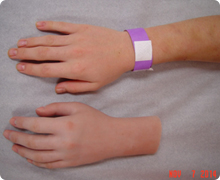Services We Offer
Services We Offer
We offer braces (orthoses) to treat a variety of conditions. These may include:
-
Ankle-foot orthosis
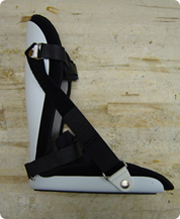 An ankle-foot orthosis (AFO) is used to help patients walk, to maintain a corrected position after casting or surgery, and to help keep muscles stretched out. There are many types of AFOs, including custom-made braces and premade braces. Some AFOs are solid at the ankle to provide stable support when standing and walking. Other AFOs have joints at the ankle to allow the brace to move with the patient while still providing support or maintaining range of motion. Some AFOs are worn during the day and some are used only for stretching at night.
An ankle-foot orthosis (AFO) is used to help patients walk, to maintain a corrected position after casting or surgery, and to help keep muscles stretched out. There are many types of AFOs, including custom-made braces and premade braces. Some AFOs are solid at the ankle to provide stable support when standing and walking. Other AFOs have joints at the ankle to allow the brace to move with the patient while still providing support or maintaining range of motion. Some AFOs are worn during the day and some are used only for stretching at night.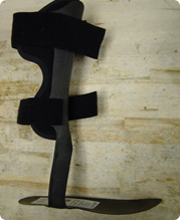
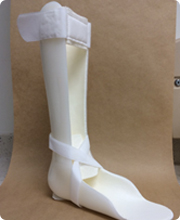
-
Bivalved body jacket
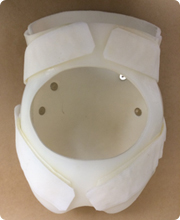 A bivalved body jacket is typically used for patients with neuromuscular scoliosis. A body jacket helps position the patient in a corrected position to provide good sitting support for daily activities.
A bivalved body jacket is typically used for patients with neuromuscular scoliosis. A body jacket helps position the patient in a corrected position to provide good sitting support for daily activities. -
Boston-style thoracolumbosacral orthosis
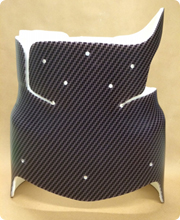 A Boston-style thoracolumbosacral orthosis (tho-ra-ko-lum-bo-SAY-krul or-THOH-sus) (TLSO) is used to treat patients with idiopathic scoliosis. This brace is made with plastic and lined with soft foam. Corrective pads are added to the inside of the brace to push on the patient’s scoliotic curve to hold it in a corrected position when the brace is on. The device is typically worn for 18 hours a day.
A Boston-style thoracolumbosacral orthosis (tho-ra-ko-lum-bo-SAY-krul or-THOH-sus) (TLSO) is used to treat patients with idiopathic scoliosis. This brace is made with plastic and lined with soft foam. Corrective pads are added to the inside of the brace to push on the patient’s scoliotic curve to hold it in a corrected position when the brace is on. The device is typically worn for 18 hours a day. -
Cervical collar
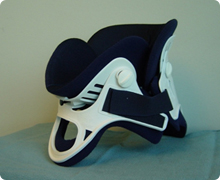 Cervical collars (neck braces) are used to provide support and stabilization for patients with cervical anomalies, neck trauma (often from a car accident or fall), or for support and comfort after surgery. There are many different types of cervical collars available at Seattle Children’s.
Cervical collars (neck braces) are used to provide support and stabilization for patients with cervical anomalies, neck trauma (often from a car accident or fall), or for support and comfort after surgery. There are many different types of cervical collars available at Seattle Children’s.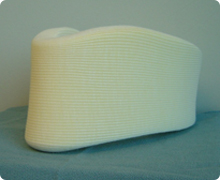
-
Cranial remolding helmet
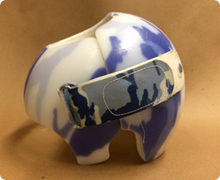 Cranial remolding helmets are used to help reshape an infant’s head if they have flattening caused by plagiocephaly (flattening of the back of the head on one side and front of the head on the opposite side) or brachycephaly (flattening of the back of the head on both sides). Helmets are also fit on patients following surgery for craniosynostosis (crane-eo-sin-ost-O-sis), a condition that occurs when 1 or more of the soft fibrous seams (sutures) in a baby's skull close earlier than normal. Helmets are usually fit when babies are 6 to 8 months old.
Cranial remolding helmets are used to help reshape an infant’s head if they have flattening caused by plagiocephaly (flattening of the back of the head on one side and front of the head on the opposite side) or brachycephaly (flattening of the back of the head on both sides). Helmets are also fit on patients following surgery for craniosynostosis (crane-eo-sin-ost-O-sis), a condition that occurs when 1 or more of the soft fibrous seams (sutures) in a baby's skull close earlier than normal. Helmets are usually fit when babies are 6 to 8 months old. -
Custom pectus brace
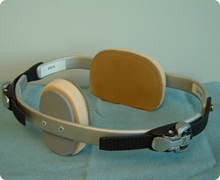 A custom pectus brace is worn to treat pectus carinatum, a breastbone (sternum) and rib cartilage deformity that causes the chest to bow outward. The brace contains a front pad that sits over the carinatum and compresses the carinatum back into a flat position to correct the chest shape.
A custom pectus brace is worn to treat pectus carinatum, a breastbone (sternum) and rib cartilage deformity that causes the chest to bow outward. The brace contains a front pad that sits over the carinatum and compresses the carinatum back into a flat position to correct the chest shape. -
Elongation, derotation, flexion thoracolumbosacral orthosis
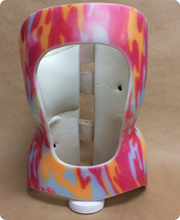 An elongation, derotation, flexion thoracolumbosacral orthosis (EDF TLSO) is usually used for young patients with infantile idiopathic scoliosis. This brace is typically used after a series of EDF casting by Orthopedics and Sports Medicine to help maintain the corrected position. The device is molded before the patient’s last corrective cast is applied. The brace is then available for fitting when the final cast is removed.
An elongation, derotation, flexion thoracolumbosacral orthosis (EDF TLSO) is usually used for young patients with infantile idiopathic scoliosis. This brace is typically used after a series of EDF casting by Orthopedics and Sports Medicine to help maintain the corrected position. The device is molded before the patient’s last corrective cast is applied. The brace is then available for fitting when the final cast is removed. 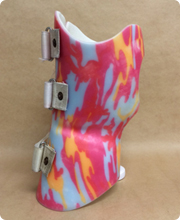
-
Humeral Sarmiento
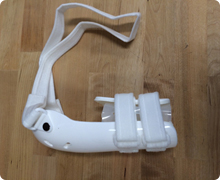 A Humeral Sarmiento is a brace that is applied to the upper arm (humerus) following a fracture in the middle of the arm. The brace is usually applied about 7 to 10 days after the fracture. It provides stabilization to the area of the fracture while still allowing movement of the shoulder, elbow and wrist.
A Humeral Sarmiento is a brace that is applied to the upper arm (humerus) following a fracture in the middle of the arm. The brace is usually applied about 7 to 10 days after the fracture. It provides stabilization to the area of the fracture while still allowing movement of the shoulder, elbow and wrist. -
Infant hip abduction brace
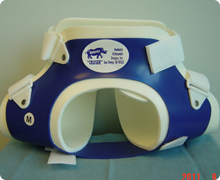 A hip abduction brace for young children is used to treat developmental dysplasia of the hip. It holds the hips bent up (flexed) and out to the sides (abducted). This is sometimes used once a baby is too big for a Pavlik harness (PDF). It can also be used following casting or surgery to help stabilize the baby’s hips as they transition back to full motion.
A hip abduction brace for young children is used to treat developmental dysplasia of the hip. It holds the hips bent up (flexed) and out to the sides (abducted). This is sometimes used once a baby is too big for a Pavlik harness (PDF). It can also be used following casting or surgery to help stabilize the baby’s hips as they transition back to full motion. -
Knee-ankle-foot orthosis
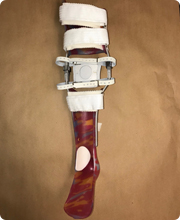 A knee-ankle-foot orthosis (KAFO) is used to help patients walk, to maintain a corrected position after casting or surgery, and to help keep muscles stretched out. There are many types of KAFOs and most are custom-made. Some KAFOs are solid at the knee and ankle and are used for positioning. These are most often used at night to help maintain range of motion. Other KAFOs have joints at the knee and/or ankle to allow the brace to move with the patient while still providing support or maintaining range of motion.
A knee-ankle-foot orthosis (KAFO) is used to help patients walk, to maintain a corrected position after casting or surgery, and to help keep muscles stretched out. There are many types of KAFOs and most are custom-made. Some KAFOs are solid at the knee and ankle and are used for positioning. These are most often used at night to help maintain range of motion. Other KAFOs have joints at the knee and/or ankle to allow the brace to move with the patient while still providing support or maintaining range of motion.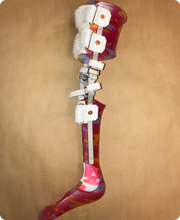
-
Lower limb prosthetics
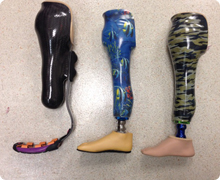 Lower limb prosthetics are fit on patients with lower limb amputations. Patients may have an amputation due to trauma, cancer treatment or because they are born with a difference in their limb that significantly limits its function. We provide prosthetic limbs for patients with amputations above and below their knee.
Lower limb prosthetics are fit on patients with lower limb amputations. Patients may have an amputation due to trauma, cancer treatment or because they are born with a difference in their limb that significantly limits its function. We provide prosthetic limbs for patients with amputations above and below their knee. -
Lumbo-sacral orthosis
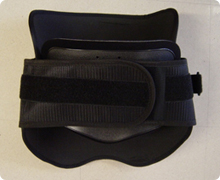 A lumbo-sacral orthosis (LSO) is used for patients with lower back pain, spondylolysis and spondylolisthesis. The severity of a patient’s lower back issue will often determine what type of bracing is needed. Some LSOs are premade and can be fit in 1 appointment. Other LSOs, like a Boston Overlap brace, are custom-made and will require 2 appointments for fitting.
A lumbo-sacral orthosis (LSO) is used for patients with lower back pain, spondylolysis and spondylolisthesis. The severity of a patient’s lower back issue will often determine what type of bracing is needed. Some LSOs are premade and can be fit in 1 appointment. Other LSOs, like a Boston Overlap brace, are custom-made and will require 2 appointments for fitting. 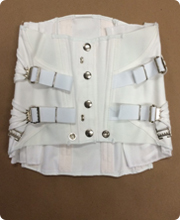
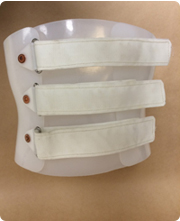
-
Newport hip abduction brace
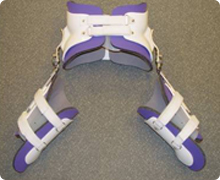 The Newport hip abduction brace is used for patients who have undergone casting or surgery on their hips to provide stabilization as they heal and transition back to full motion. It can also be used for patients who have had a thigh bone (femur) fracture and surgery to provide stabilization and improve comfort as they heal.
The Newport hip abduction brace is used for patients who have undergone casting or surgery on their hips to provide stabilization as they heal and transition back to full motion. It can also be used for patients who have had a thigh bone (femur) fracture and surgery to provide stabilization and improve comfort as they heal. -
Pavlik harness
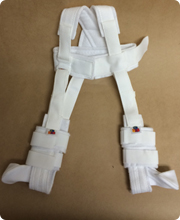 A Pavlik harness is used to treat developmental dysplasia of the hip. It features a series of soft straps that hold the hips bent up (flexed) to 90 degrees to allow for good alignment and help the development of the baby’s hips. A Pavlik harness may also be placed on an infant with a broken thigh bone (femur) instead of a cast to help hold the leg in a good position while the bone heals.
A Pavlik harness is used to treat developmental dysplasia of the hip. It features a series of soft straps that hold the hips bent up (flexed) to 90 degrees to allow for good alignment and help the development of the baby’s hips. A Pavlik harness may also be placed on an infant with a broken thigh bone (femur) instead of a cast to help hold the leg in a good position while the bone heals. -
Ponseti ankle-foot orthosis and abduction bar
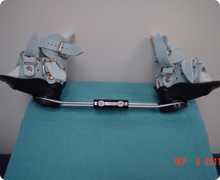 A Ponseti ankle-foot orthosis (AFO) and abduction bar, sometimes called “boots and bar,” is used to help maintain a patient’s corrected position following treatment for clubfoot, metatarsus adductus (PDF) and vertical talus, a rare deformity of the foot. They are often worn 23 hours a day for the first 3 months of treatment and then at night and naptime for the remainder of the treatment.
A Ponseti ankle-foot orthosis (AFO) and abduction bar, sometimes called “boots and bar,” is used to help maintain a patient’s corrected position following treatment for clubfoot, metatarsus adductus (PDF) and vertical talus, a rare deformity of the foot. They are often worn 23 hours a day for the first 3 months of treatment and then at night and naptime for the remainder of the treatment. -
Providence thoracolumbosacral orthosis
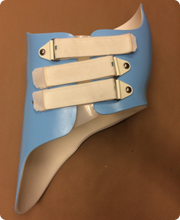 A Providence thoracolumbosacral orthosis (TLSO) is used to treat patients with idiopathic scoliosis. The brace is made with plastic and lined with soft foam. Corrective pads are built into the brace to apply corrective force to the spine to hold the spine in a straighter position when the brace is on. A Providence TLSO is used for 8 to 10 hours per night. It is most effective on a few specific curve types and sizes.
A Providence thoracolumbosacral orthosis (TLSO) is used to treat patients with idiopathic scoliosis. The brace is made with plastic and lined with soft foam. Corrective pads are built into the brace to apply corrective force to the spine to hold the spine in a straighter position when the brace is on. A Providence TLSO is used for 8 to 10 hours per night. It is most effective on a few specific curve types and sizes. -
Straight last shoes
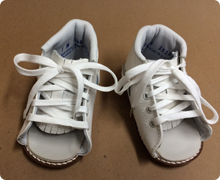 Straight last shoes were traditionally used to help maintain a patient’s corrected position following treatment for clubfoot. We now use them primarily for young children in the treatment of metatarsus adductus (PDF), the inward turning of the front half of the foot.
Straight last shoes were traditionally used to help maintain a patient’s corrected position following treatment for clubfoot. We now use them primarily for young children in the treatment of metatarsus adductus (PDF), the inward turning of the front half of the foot. -
Supramalleolar ankle-foot orthosis
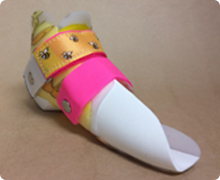 Supramalleolar ankle-foot orthosis (SMAFO) is used to provide foot support and side-to-side support for a person who needs mild support for standing and moving around.
Supramalleolar ankle-foot orthosis (SMAFO) is used to provide foot support and side-to-side support for a person who needs mild support for standing and moving around. -
Thoraco-lumbo-sacral-hip orthosis
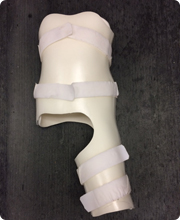 A thoraco-lumbo-sacral-hip orthosis (TLSHO) is typically used on patients who have undergone surgery to treat spine slippage (spondylolisthesis). This brace covers the patient’s torso and crosses the hip joint to also cover one of the patient’s thighs. The thigh extension is used to help stabilize the lower back and prevent excessive movement between sections of the lower back (lumbar and sacral spine).
A thoraco-lumbo-sacral-hip orthosis (TLSHO) is typically used on patients who have undergone surgery to treat spine slippage (spondylolisthesis). This brace covers the patient’s torso and crosses the hip joint to also cover one of the patient’s thighs. The thigh extension is used to help stabilize the lower back and prevent excessive movement between sections of the lower back (lumbar and sacral spine). 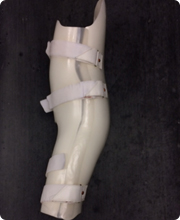
-
Twister cables
Twister cables are used to control the rotation of the lower extremities due to muscle imbalance. These devices are typically attached to bilateral ankle-foot orthoses (AFOs).
-
Upper limb prosthetics
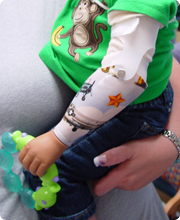 Upper limb prosthetics are fit on patients missing part of their arm because of trauma, cancer treatment or they were born with a difference in their limb that significantly limits its function. We provide prosthetic limbs for patients above and below their elbow.
Upper limb prosthetics are fit on patients missing part of their arm because of trauma, cancer treatment or they were born with a difference in their limb that significantly limits its function. We provide prosthetic limbs for patients above and below their elbow.